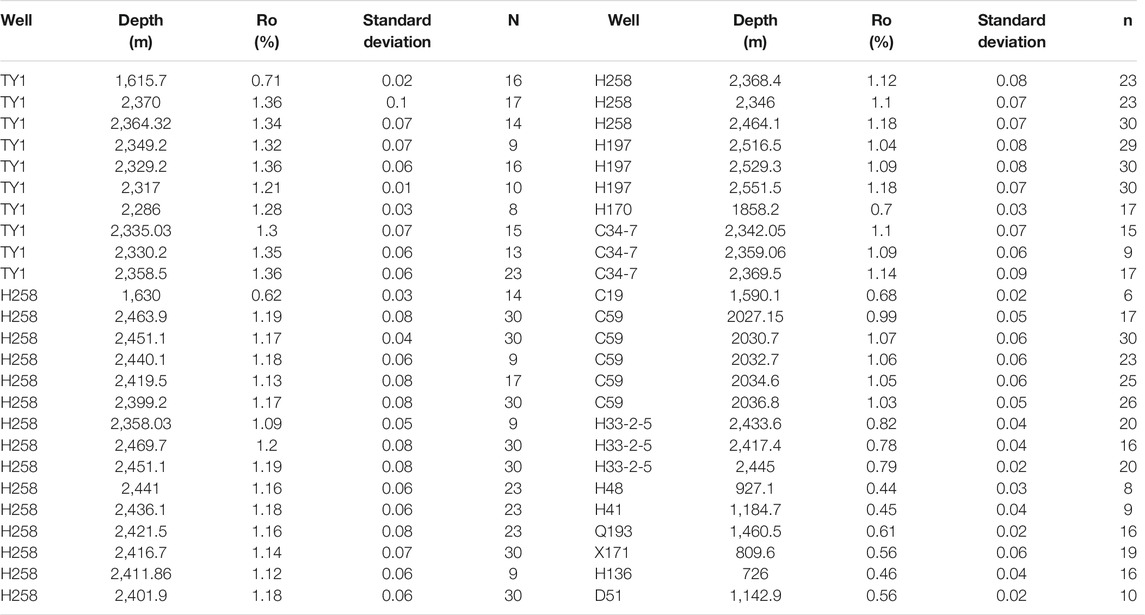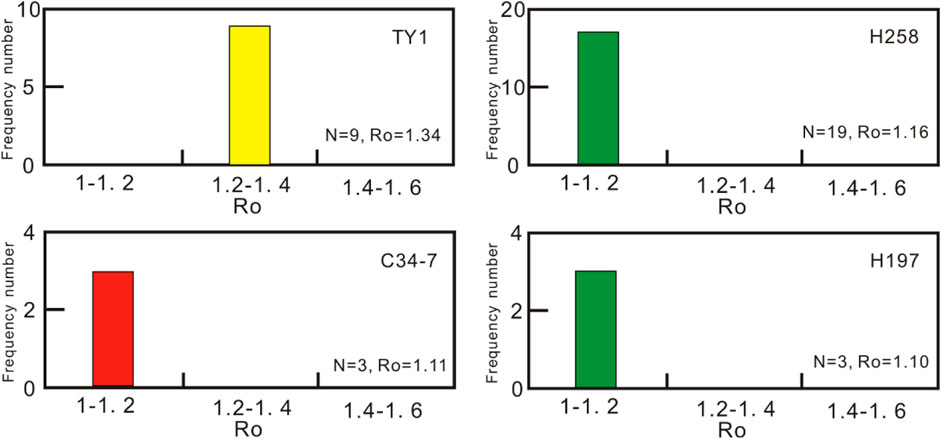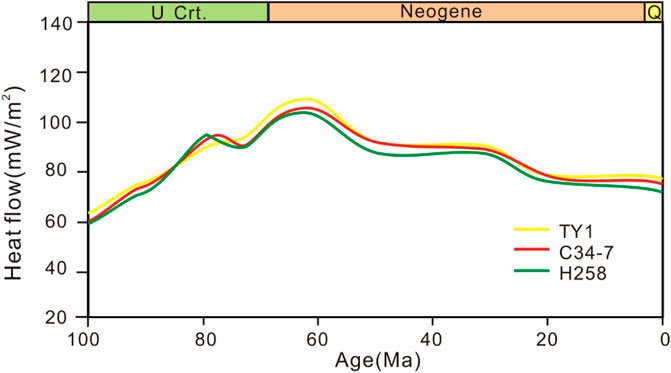- 1College of Geosciences, Northeast Petroleum University, Daqing, China
- 2Key Laboratory of Continental Shale Hydrocarbon Accumulation and Efficient Development, Ministry of Education, Northeast Petroleum University, Daqing, China
- 3Institute of Unconventional Oil and Gas, Northeast Petroleum University, Daqing, China
- 4PetroChina Jilin Oilfield Company, China National Petroleum Corporation, Songyuan, China
A series of significant shale oil discoveries have been made recently in the Upper Cretaceous Qingshankou Formation in the Songliao Basin, providing a new resource target for shale oil exploration in Northeast China. In this context, an understanding of the tectonic-thermal evolution and maturation history of the Qingshankou Formation is of great significance for shale oil exploration and evaluation. In this study, the thermal history of the Qingshankou Formation since the Late Cretaceous was reconstructed using the paleothermal indicator method. The results indicate that two stages of thermal evolution exist in the southern part of the Songliao Basin: 1) the gradual heating stage during the Late Cretaceous; the heat flow gradually increases during this period and reaches a maximum heat flow value at the end of the Cretaceous. 2) The decline stage since the Neogene; the tectonic activity is relatively stable and the geothermal heat flow is gradually reduced, and the present-day heat flow ranges from 60.1 to 100.7 mW/m2, with an average of 78.2 mW/m2. In addition, the maturity history of the organic-rich shale was reconstructed based on the new thermal history. The Cretaceous Qingshankou shales underwent deep burial thermal metamorphism at the end of the Cretaceous, whereas thermal has faded since the Neogene. The hydrocarbon generation and migration since the Late Cretaceous period of K2qn1 were modeled based on the maturity model. Two main cooling events took place in the late Nenjiang period and the late Mingshui period in the Changling sag. These two tectonic events controlled the structural style and the formation of shale oil reservoirs in the southern Songliao Basin.
Introduction
Rapid growth of the global demand for petroleum and gas resources has promoted exploration and development recently (International Energy Agency, 2011; Wang et al., 2015). Furthermore, with the successful development of shale gas in China, the exploration of shale oil has also been actively promoted (Jia et al., 2018; Sun et al., 2019; Zhang et al., 2020). The resource potential of shale oil in China has been verified and has mainly occurred in continental strata (such as the Cretaceous formation of the Songliao Basin, the Upper Permian formation of the Junggar Basin and the Santanghu Basin, and the Upper Triassic formation of the Ordos Basin) (Liu et al., 2012; Zou et al., 2013; Gao et al., 2016). Significant exploration breakthroughs and discoveries of shale oil have been made recently in the Upper Cretaceous Qingshankou Formation in the Songliao Basin, providing a new resource target for shale oil exploration in Northeast China (Liu et al., 2017, 2019a, 2019b, 2021; Zhao et al., 2020). Previous studies mainly focused on the geochemical characteristics, lithofacies types, and the shale oil enrichment pattern of the Qingshankou Formation, indicating that the shale oil in the Qingshankou Formation (K2qn), especially in the first member (K2qn1), represents a promising replacement resource for conventional oil (Liu et al., 2017, 2019a, 2019b; Zhang et al., 2020).
Thermal history is of great significance for studying the evolution of formation temperature, hydrocarbon generation, and primary migration histories (Pang et al., 2012; Kosakowski and Krzywiec, 2013; Zuo et al., 2015; Xu et al., 2018; Yu et al., 2020; Nansheng et al., 2021). The current methods for restoring the thermal history of sedimentary basins are generally divided into two categories. One is the paleothermal indicator method, mainly including vitrinite reflectance (Ro), fluid inclusions, clay mineral transformation, fission tracks (AFT and ZFT), and (U-Th)/He (Sweeney and Burnham, 1990; Crowley and Kevin, 1991; Tissot and Welte, 2013). The other uses the thermodynamic model to restore the thermal history of the basin (He et al., 2001, 2011; He, 2014). The former method has higher accuracy for sedimentary basins due to the fact that the simulation results can be verified with measured data. Previous studies mainly focused on the denudation and burial history of the Songliao Basin (Guo et al., 2009; Shi L. et al., 2019). However, little effort was put into reestablishing the thermal history and maturation histories of Qingshankou shale in the southern Songliao Basin. As the main controlling factor for source rock maturity, the pre-Cretaceous thermal history of the southern Songliao Basin should be restored to determine the hydrocarbon generation history and resource potential of the Qingshankou source rocks.
In this study, we reconstructed the tectonic-thermal evolution of the Qingshankou (K2qn) Formation using a series of vitrinite reflectance. We modeled the thermal evolution of the source rocks in the southern Songliao Basin since the Late Cretaceous. In addition, based on the various geochemical parameters and the simulation method, the timing of hydrocarbon generation and the primary migration of the Qingshankou (K2qn) source rocks are discussed. This study provides guidelines for shale oil exploration in the Cretaceous Qingshankou Formation of the southern Songliao Basin.
Geological Setting
The Songliao Basin, located in Northeast China, has a strike extension to the northeast/north-northeast (NE–NNE). It is a composite Mesozoic–Cenozoic sedimentary basin, covering an area of approximately 2.6 km2 × 105 km2, extending 7.5 m × 104 m in length and (3.3–3.7)×104 m in width. The basin can be subdivided, based on basement morphology, major faults, structural deformation, and sediment distribution, into six first-order tectonic units, including northern plunge, western slope, southwestern uplift, southeastern uplift, northeastern uplift, and central depression (Liu et al., 2021) (Figure 1A). With the Songhua River, the Nen River, and the Lalin River as the geographical boundaries, the Songliao Basin can be divided into two parts: the Daqing Oilfield exploration area in the north and the Jilin Oilfield exploration area in the south. The Jilin exploration area in the southern part of the central depression can be further divided into four secondary tectonic units: the Honggang terrace, the Changling sag, the Fuxin uplift belt, and the Huazijing terrace. For this study, the sampling wells are located in the northern part of the Changling sag (Figure 1B). The Changling sag is located in the southern part of the central depression. It is a large and gentle depression with a northeast trend and an area of about 6,500 km2. It connects to the Gulong Sag to the north and is clamped by the Honggang terrace and the Huazijing terrace to the northwest and the southeast, respectively.
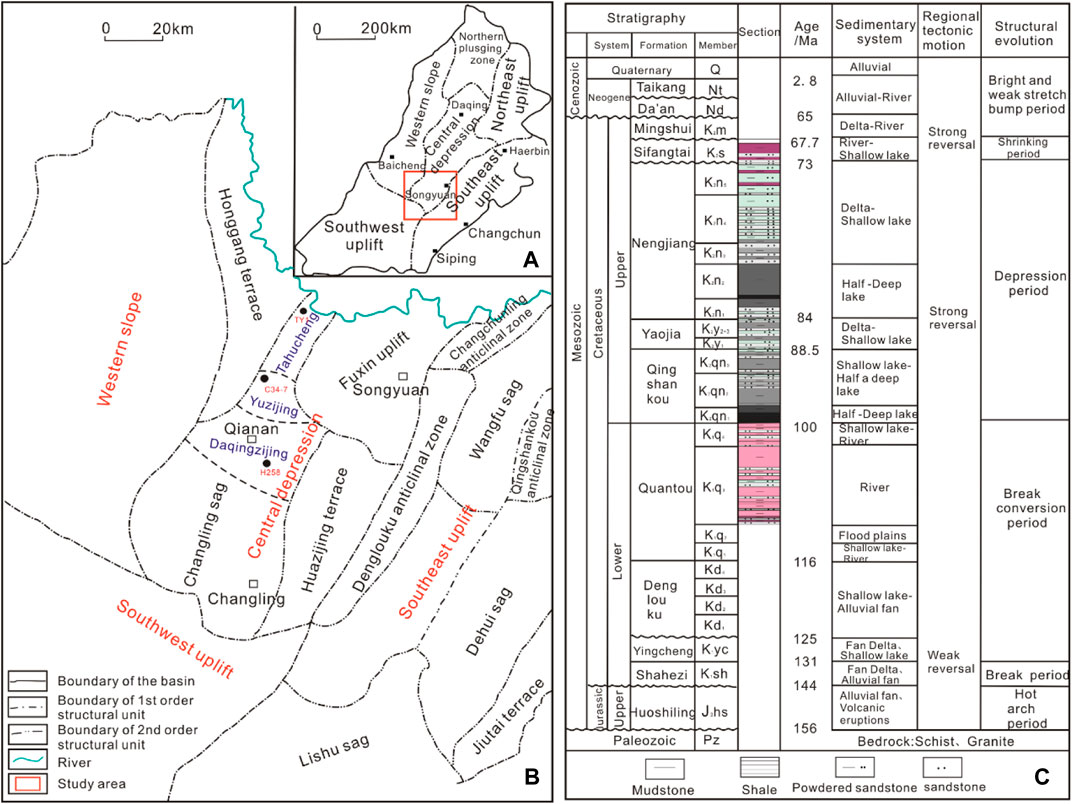
FIGURE 1. (A) Simplified distribution map of the tectonic units in the Songliao Basin. (B) Enlarged view of the southern part of the central depression of the Songliao Basin. (C) Composite stratigraphic columnar section of the southern part of the Songliao Basin [modified following Huang et al. (2011)].
The Changling sag exhibits obvious characteristics of fault–depression superimposed sedimentation. During the faulting period, the main sedimentary formations are the Upper Jurassic–-Lower Cretaceous Huoshiling Formation (J3h), Shahezi Formation (K1sh), Yingcheng Formation (K1yc), and Denglouku Formation (K1d), with a maximum thickness of 5,000–7,000 m, which is dominated by terrigenous clastic rocks, volcanic rocks, and pyroclastic rocks. In the depression stage of the basin, the deposited formation includes the Lower Cretaceous Quantou Formation (K1q) and the Upper Cretaceous Qingshankou Formation (K2qn), Yaojia Formation (K2y), Nenjiang Formation (K2n), Sifangtai Formation (K2s), and Mingshui Formation (K2m). These strata are dominated by terrigenous clastic rocks, among which the Qingshankou Formation (K2qn) serves as the main source rock for the shallower reservoirs in the basin (Figure 1C). The Qingshankou Formation can be further divided into the first member (K2qn1), the second member (K2qn2), and the third member (K2qn3). The K2qn2 and K2qn3 members are widely distributed in the basin with a thickness of 250–550 m. The corresponding lithology is mainly dark gray mudstone and fine sandstone, interbedded. The K2qn2 and K2qn3 members integrated contact with the K2qn1 member and the overlying Yaojia Formation. The lithology of the K2qn1 is mainly stable and thick semi-deep lake facies consisting of gray-black mudstone, which was deposited during the first large-scale lacustrine transgression in the basin (Wu et al., 2008; Feng et al., 2010; Liu et al., 2017; Zhang et al., 2020; Liu et al., 2019a, 2019b, 2021). The Songliao Basin has gone through four stages of structural evolution: the volcanic eruption and tension fracture stage (T-J3), the chasmic stage (J3-K1), the depression stage (K1-K2), and the tectonic reversal phase (K2-Q).
Modeling Procedure
Burial History Model
Burial history reconstruction is the basis for thermal history modeling. In this part, the basic geological data, including the thickness, depths, lithologies, and geological ages, referred to the previous studies to construct burial histories (Shi Y. et al., 2019; Guo et al., 2009; Song et al., 2018; Fu et al., 2020). In addition, the erosion events and corresponding eroded thickness are site-specific and were thus considered separately. Since the Late Cretaceous, two main erosion events have taken place in the late Nenjiang Formation and the late Mingshui Formation of the Changling sag. As a result, two corresponding unconformities developed: the unconformity between the Sifangtai and the underlying Nenjiang strata and the unconformity between the Mingshui and the underlying Da’an strata (Guo et al., 2009; Song et al., 2018; Fu et al., 2020). The erosion amounts at the end of the Nenjiang Formation and the Mingshui Formation are 100–300 m and 200–500 m, respectively, and the extent of the erosion amounts gradually decreases from east to west (Table 1), which is due to the influence of the Pacific plate subducting westward in the late Paleozoic (Song et al., 2018).
Present Thermal Regime
In the thermal history recovery, the present temperature is one of the important constraints. The well-testing temperature is the ground temperature data obtained during the test oil pressure measurement in the oil-bearing interval of the development well, reflecting the temperature situation of boreholes. The present temperature and the geothermal gradient of forty-three wells in the Qingshankou Formation are shown in Figure 2 and Table 2. The well-testing temperatures of boreholes demonstrated roughly linear temperature–depth relations, which means that the heat transfer in those boreholes is mainly via heat conduction. The present temperature in the Daqingzijing area, Yuzijing area, and Tahucheng area of the Qingshankou Formation is 95.7, 102, and 92.2°C, respectively (Figure 2A). The current geothermal gradient in the Daqingzijing area, Yuzijing area, and Tahucheng area of the Qingshankou Formation is 36.9, 38.9, and 40.28°C/km, respectively, showing that the present geothermal gradient gradually increases from south to north (Figure 2B).
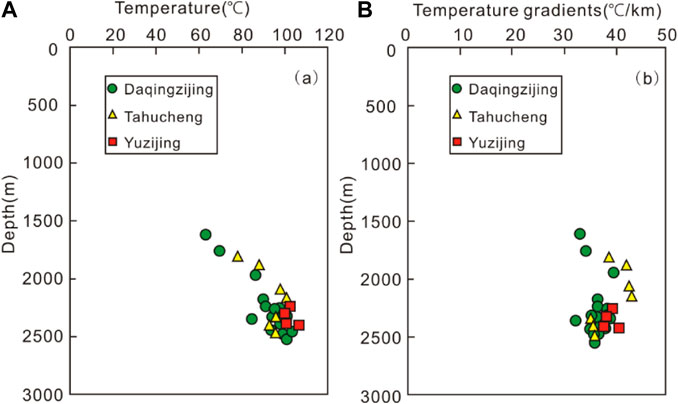
FIGURE 2. (A) Temperature–depth profiles and (B) temperature gradient–depth profiles for the selected boreholes in the southern part of the Songliao Basin.
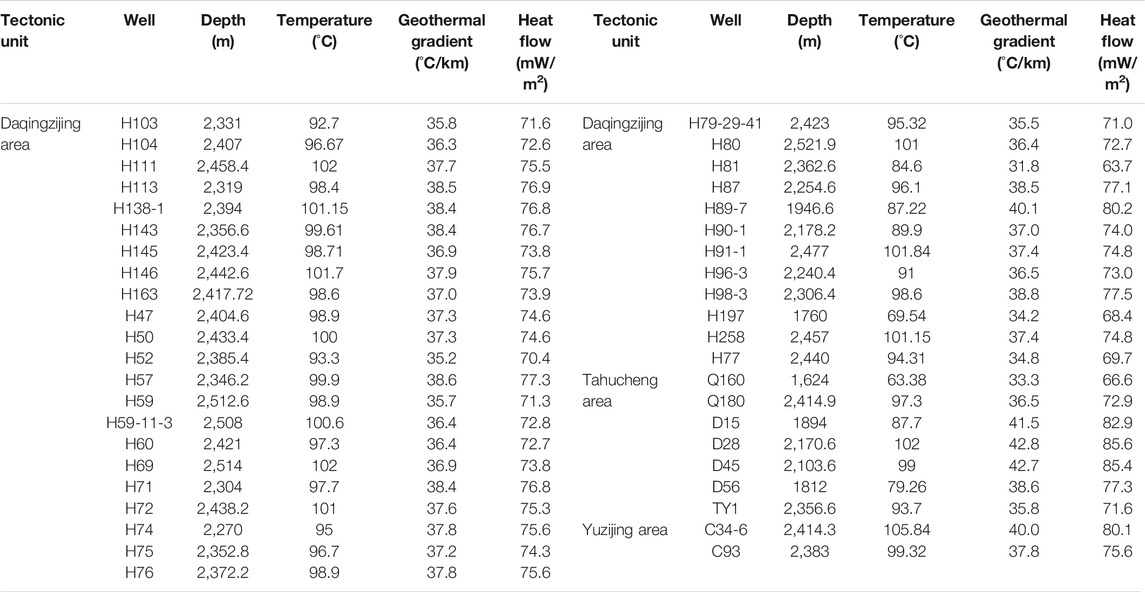
TABLE 2. Results of temperature, geothermal gradient, and heat flow in the southern part of the Songliao Basin.
Previous studies have measured the thermal conductivities from 435 core samples in the southern part of the Songliao Basin (Shi L. et al., 2019; Ma et al., 2019). These samples represent almost every lithology in different formations, including sandstone, shale, conglomerate, and volcanic. The frequency distribution histogram of the thermal conductivity of each lithological rock (Figure 3) shows that the average thermal conductivity value of shale is the lowest and the distribution range is 1.28–3.79 W/(mK), with a mean of 2.32 ± 0.48 W/(mK). Thus, the thermal conductivity shows a clear increasing trend with increasing depth. The thermal conductivity of sandstone is 1.85–4.48 W/(mK), with an average of 2.67 ± 0.33 W/(mK). The thermal conductivity of the conglomerate is 1.92–3.26 W/(mK), with an average of 2.72 ± 0.33 W/(mK). Finally, the volcanic thermal conductivity is relatively low, with an average of 2.54 ± 0.33W/m/K.
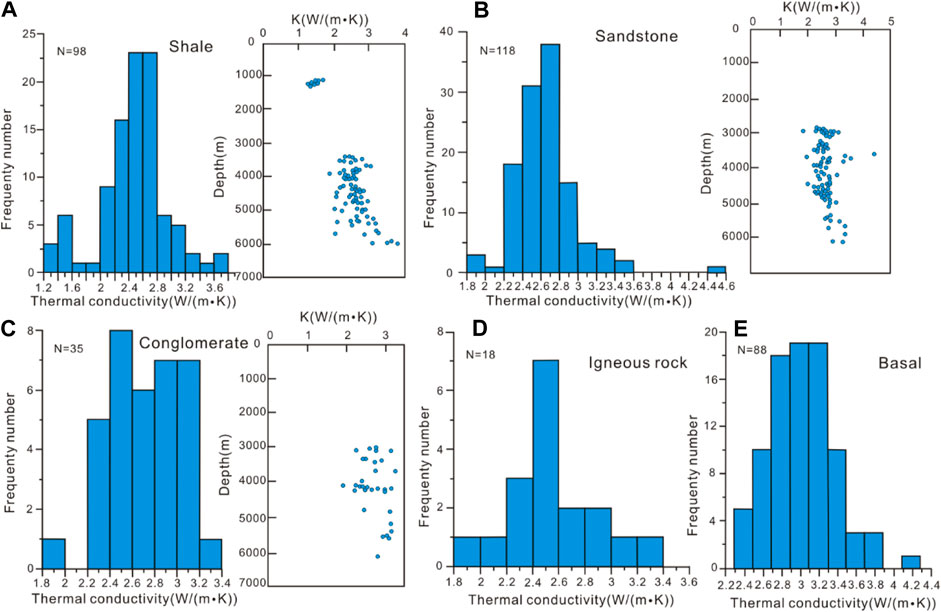
FIGURE 3. Histogram of measured thermal conductivity of different lithologies in the Songliao Basin. (A) Shale; (B) sandstone; (C) conglomerate; (D) igneous rock; and (E) basement (modified following Shi Y. et al., 2019).
The present-day heat flow directly determines the thermal evolution and is a key input parameter in thermal history evolution (Qiu et al., 2012; Zhu et al., 2018). The surface heat-flow value was calculated using the temperature gradient and the harmonic mean thermal conductivity, as shown in Eq. 1. The harmonic mean thermal conductivity of the southern Songliao Basin is about 2.35 ± 0.33 W/(mK), using the measured thermal conductivity values and the thickness of different formations. Present-day heat flows in the southern part of the Songliao Basin range from 60.1 to 100.7 mW/m2, with an average of 78.2 mW/m2. Comparison with the northeast uplift, western slope, and southeast uplift of the Songliao Basin reflects a background with typically high heat flow (Ren et al., 2001; Ren et al., 2011), as shown below:
where
Thermal History Reconstruction
Analytical Results of Equivalent Vitrinite Reflectance
We measured fifty vitrinite reflectance (%Ro) values from fourteen wells in the southern part of the Songliao Basin (Table 3). The vitrinite reflectance values of K2qn1 range from 0.99 to 1.36% Ro (average: 1.17% Ro), and the Ro of K2qn1 in the Tahucheng area (mean: 1.34%) is higher than that in the Yuzijing and Daqingzijing areas (mean: 1.11 and 1.10%) (Figure 4). In this study, the vitrinite reflectance profiles (%Ro) from three typical wells all show increasing trends with depth (Figure 5), indicating that all the strata reached a maximum temperature at the same time.
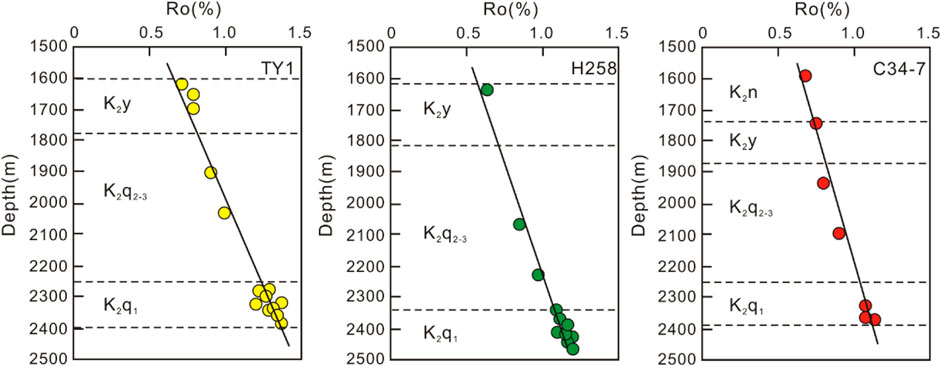
FIGURE 5. Vitrinite reflectance (%Ro) vs. depth of three typical wells in the southern part of the Songliao Basin.
Burial and Thermal Results
This study used the equivalent vitrinite reflectance as the constraint condition and used the ancient heat flow method to recover the thermal history. The main steps are as follows: 1) we need to determine the amount of denudation in each period and the basic geological parameters such as the thickness of the formation, the depth of the top and the bottom of the formation, lithology, and physical properties; 2) we assume a heat flow evolution history based on the tectonic geological background, and the parallel reaction model (EASY%Ro) is used to calculate the Ro value; 3) repeatedly modify the assumed thermal history so that the measured Ro value and the corresponding EASY% Ro theoretical model calculation value reach the best fit, and it is considered that the thermal history that can correctly reflect the basin’s tectonic-thermal evolution process is obtained at this time. The burial and thermal simulation results of three typical wells in different tectonic units of the Changling sag are presented in Figures 6A,C,E. The best matches between the measured and the modeled vitrinite reflectance were achieved (Figures 6B,D,F), indicating that the simulation results are reliable (Opera et al., 2013; Mohamed et al., 2016). The t-T thermal paths of three typical wells (Figures 6A,C,E) show that all samples underwent an overall heating stage after their deposition during the Late Cretaceous, followed by a slow cooling phase from the latest Cretaceous to recent times. In the Cretaceous, affected by the episodic westward compression from the Pacific Plate (Kusky et al., 2016; Song et al., 2018; Wang et al., 2020), the sedimentary strata of the southern Songliao Basin suffered small-scale erosion. From the Early Cretaceous to the end of the Late Cretaceous, the study area subsided rapidly. The maximum subsidence rate reached nearly 120 m/Ma and reached the maximum burial depth of K2qn1 at a depth of ∼2,400 m at the end of the Late Cretaceous. In this stage, the geothermal gradient is about ∼49°C/km, and the maximum temperature of K2qn1 reached ∼128°C. Thus, the maximum temperature and heat flow occurred at the end of the Cretaceous (Figure 7). This result was also proved by the apatite fission track data published by previous studies (Cheng et al., 2018; Song et al., 2018). There are two phases of heat flow evolution in the southern part of the Songliao Basin: 1) the gradual heating stage during the Late Cretaceous; the heat flow gradually increases during this period and reaches the maximum heat flow value at the end of the Cretaceous. 2) The decline stage since the Neogene; the tectonic activity is relatively stable, and the geothermal heat flow is gradually reduced during this period, while the present-day heat flows range from 60.1 to 100.7 mW/m2, with an average of 78.2 mW/m2.
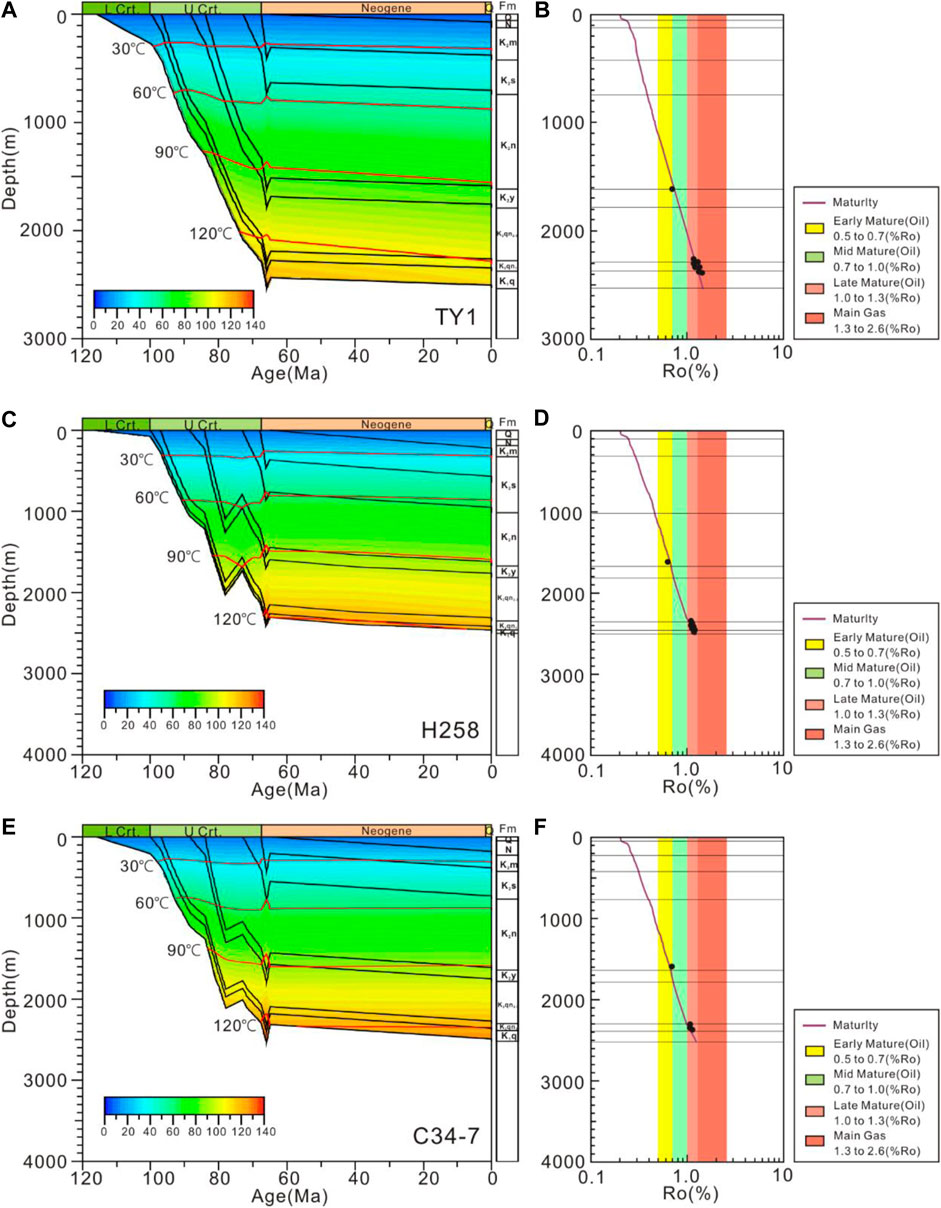
FIGURE 6. The burial histories of the TY1 well (A), the H258 well (C) and the C34-7 well (E), and the thermal models of the TY1 well (B), the H258 well (D) and the C34-7 well (F) in the southern part of the Songliao Basin.
Discussion
Maturation Histories of the Qingshankou Source Rocks
The maturation histories of the source rocks control the timing of hydrocarbon generation and migration (Carminati et al., 2010; Hudson and Hanson, 2010; Pang et al., 2012; Kosakowski and Krzywiec, 2013). The maturity histories of Qingshankou source rocks were calculated based on the constraints of newly obtained Ro data and the current temperature. The thermal model shows that the K2qn1 source rocks underwent an overall rapid heating stage after deposition during the Cretaceous and retained thermal maturation until the present day. In the well of C34–7 and H258, the K2qn1 source rocks entered the early maturation stage (0.5% < Ro<0.7%) and began to form hydrocarbons since ∼85 Ma. At the end of the Late Cretaceous, with the study area subsiding rapidly, the maturity of the source rock entered the middle maturation stage (0.7% < Ro < 1.0%) and formed a large amount of oil. At present, the maturity of the source rock has mostly maintained the characteristics of the end of the Cretaceous. On the other hand, in the well of TY1 of the Tahucheng area, the thermal maturation is slightly higher than that of the Yuzijing and Daqingzijing areas (well C34–7 and H258), and it enters the late maturation stage (1.0% < Ro < 1.3%) at present. It is because the Tahucheng area is the center of deposition, and the buried depth is deeper here than it is in the other two areas. Hence, the thermal maturity of Qingshankou source rocks is slightly higher (Figure 8).
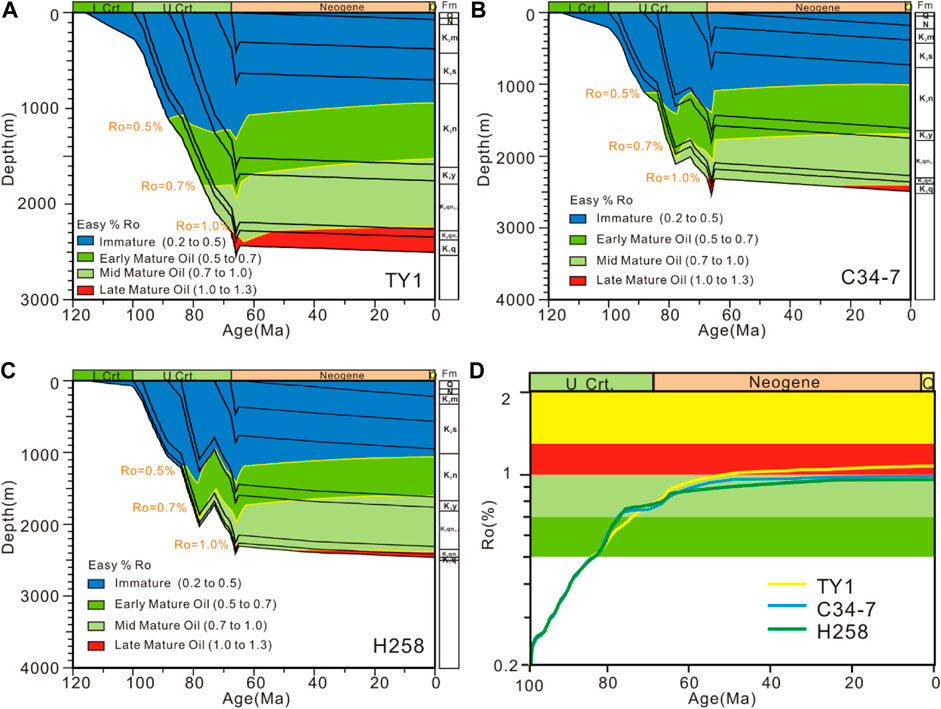
FIGURE 8. Thermal maturity model of the TY1 well (A), C34-7 well (B), H258 well (C), and the evolution profile of vitrinite reflectance (Ro) of three typical wells (D) in the southern part of the Songliao Basin. Timing of hydrocarbon generation and primary migration.
Based on the maturity model, the timing of hydrocarbon generation and primary migration since the Late Cretaceous period of K2qn1 has been modeled. The results showed that the hydrocarbon generation started from the Late Cretaceous (85 Ma). The maturity of source rocks reached the early oil stage (0.5% < Ro < 0.7%) when a small amount of oil was generated, and the expulsion ratio is almost zero (Figure 9). At the end of the Late Cretaceous, the K2qn1 source rock began to generate a large amount of hydrocarbon with the rapid increase in the temperature (Figure 9), and the hydrocarbon migration took place at the end of the Late Cretaceous (68 Ma). Since the Neogene period, the maturity has mostly maintained characteristics of the end-Cretaceous; the hydrocarbon generation and expulsion of K2qn1 increase slowly, and the expulsion ratio reaches about 50%.
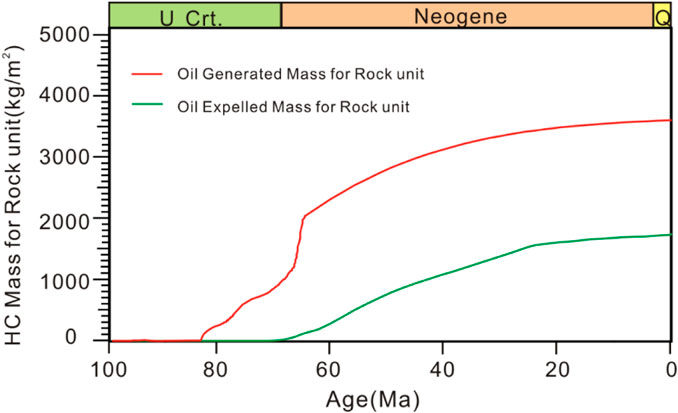
FIGURE 9. Hydrocarbon generation and primary migration of the K2qn1 source rock in the southern part of the Songliao Basin.
Additionally, the shale oil expulsion pattern of the K2qn1 was established according to the (S1 + S2) and TOC data of the Songliao Basin (Fu and Pang, 2008). The inflection point of the variation of (S1 + S2)/TOC with burial depth is 1,900 m, indicating that the K2qn1 began to expel hydrocarbons from 1,900 m. According to the burial and thermal histories, hydrocarbon expulsion started at the end of the Late Cretaceous, consistent with the conclusions of modeling results. With the increase in burial depth, the rate of hydrocarbon expulsion first increases and then decreases, reaching the maximum at about 2,200 m. The corresponding hydrocarbon expulsion rate is about 20.2 mg/g.100 m. At the depth of about 2,400 m, the hydrocarbon expulsion efficiency of the source rock reaches about 50% (Figure 10).
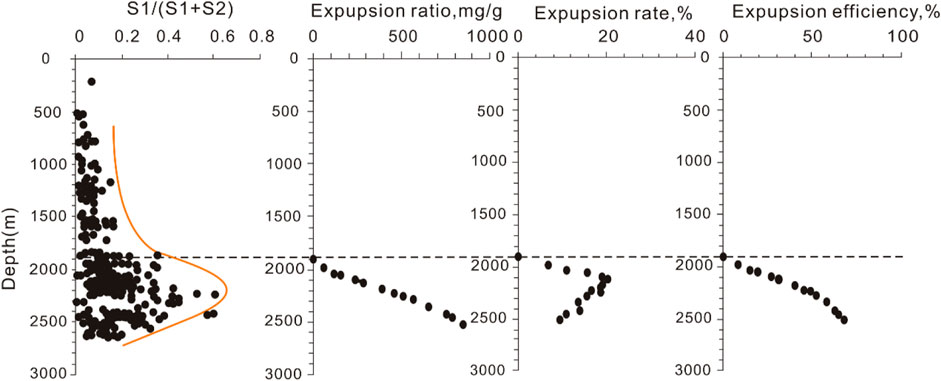
FIGURE 10. Shale oil expulsion model of the K2qn1 in the southern part of the Songliao Basin [modified following Liu et al. (2017)].
In summary, the main hydrocarbon generation stage lasted from the Late Cretaceous to the Paleogene period (68–50 Ma). The rapid burial depth led to an increase in the temperature of the K2qn1, which greatly promoted the conversion of organic matter to hydrocarbons. This result led to significant hydrocarbon generation, forming a large amount of oil in the southern part of the Songliao Basin.
Relationship between the thermal history and tectonic evolution.
Since the Late Cretaceous, two main cooling events took place in the late Nenjiang period and the late Mingshui period of the Changling sag. In the late Nenjiang period, the Yanshan movement began to break out, and it was the squeeze fold movement covering the southern part of the Songliao Basin. During this period, the tectonic stress gradually decreases from south to north. So, the extent of cooling in the Daqingzijing area is higher than that in the Tahucheng area. The other squeeze fold movement took place in the late Mingshui period. However, the uplift amplitude is much lower than that of the uplift at the end of the Nenjiang, so the original sedimentary features are retained.
In the late Nenjiang period and the late Mingshui period, there was a period of compression tectonic movement, respectively, and the influence of these two tectonic movements on the formation of shale oil is different. The tectonic movements of the late Nenjiang period mainly controlled the structural style of the Songliao Basin, which was the most intense structural movement affecting the entire Songliao Basin. The structural movement during this period formed the uplift belts in the eastern and southern Songliao Basin. On the other hand, the tectonic movements of the late Mingshui period mainly controlled the formation of shale oil reservoirs. During this period, the source rock matured rapidly, generating and expelling a large amount of oil. Comparing these two movements, the effect of the late Mingshui movement on the formation of shale oil reservoirs in the Changling area is significantly greater than that of the Nenjiang movement.
Conclusions
The thermal history of the southern Songliao Basin since the Late Cretaceous has been reconstructed using an integrated Ro data and Basinmod situation. The results show that two phases of thermal evolution exist in the southern part of the Songliao Basin: 1) the gradual heating stage from the Late Cretaceous to the Late Cretaceous; the heat flow gradually increases during this period, and it reaches the maximum heat flow value at the end of the Cretaceous. 2) The decline stage since the Neogene; the tectonic activity is relatively stable, and the geothermal heat flow is gradually reduced during this period, while the present-day heat flows range from 60.1 mW/m2 to 100.7 mW/m2, with an average of 78.2 mW/m2.
The maturity histories of the source rocks were modeled based on the new thermal histories. The result indicates that the hydrocarbon generation started from the Late Cretaceous (85 Ma). The maturity of source rocks reached the early oil stage (0.5% < Ro < 0.7%) with a small amount of oil generation, and the expulsion ratio is almost zero. At the end of the Late Cretaceous, with the rapid increase in the temperature of the K2qn1 source rock, the source rock began to generate a large amount of hydrocarbon. Meanwhile, the hydrocarbon expulsion occurred at the end of the Late Cretaceous (68 Ma). Since the Neogene period, the maturity mostly maintained the characteristics of the end of the Cretaceous; the hydrocarbon generation and expulsion of K2qn1 increased slowly, and the expulsion ratio is about 50%.
In summary, the Cretaceous Qingshankou source rocks underwent deep burial thermal metamorphism at the end of the Late Cretaceous and thermal fading since the Neogene. Two main cooling events took place in the late Nenjiang period and the late Mingshui period, which controlled the structural style and the formation of shale oil reservoirs in the southern Songliao Basin.
Data Availability Statement
The original contributions presented in the study are included in the article/Supplementary Material, further inquiries can be directed to the corresponding author.
Author Contributions
BL devised the project. YL provided the main conceptual ideas and wrote the manuscript. LC, JX, SH, and ST helped with the sampling and data analysis, and SD worked on technical details and part of the thermal analysis. All authors contributed to the article and approved the submitted version.
Funding
This work was financially supported by the National Natural Science Foundation of China (42002142 and 41972156) and the Heilongjiang Province Talent Introduction Research Start-up Funds (1305021851).
Conflict of Interest
The author JX was employed by PetroChina Jilin Oilfield Company.
The remaining authors declare that the research was conducted in the absence of any commercial or financial relationships that could be construed as a potential conflict of interest.
References
Carminati, E., Cavazza, D., Scrocca, D., Fantoni, R., Scotti, P., and Doglioni, C. (2010). Thermal and Tectonic Evolution of the Southern Alps (Northern Italy) Rifting: Coupled Organic Matter Maturity Analysis and Thermokinematic Modeling. Bulletin 94, 369–397. doi:10.1306/08240909069
Cheng, Y., Wang, S., Li, Y., Ao, C., Li, Y., Li, J., et al. (2018). Late Cretaceous-Cenozoic Thermochronology in the Southern Songliao Basin, NE China: New Insights from Apatite and Zircon Fission Track Analysis. J. Asian Earth Sci. 160, 95–106. doi:10.1016/j.jseaes.2018.04.015
Crowley, K. D., and Kevin, D. (1991). Thermal History of Michigan Basin and Southern Canadian Shield from Apatite Fission Track Analysis. J. Geophys. Res. 96 (B1), 697–711. doi:10.1029/90jb02174
Feng, Z., Jia, C., Xie, X., Zhang, S., Feng, Z., and Cross, T. (2010). Tectonostratigraphic Units and Stratigraphic Sequences of the Nonmarine Songliao Basin, Northeast China. Basin Res. 22, 79–95. doi:10.1111/j.1365-2117.2009.00445.x
Fu, X., and Pang, X. (2008). Expulsion Characteristics of Qing-1 Member Source Rock, Northern Songliao Basin. J. Oil Gas Technol. 30, 166–169.
Fu, X., Shi, H., Meng, Q., Liu, B., Liang, J., and He, J. (2020). Controlling Effects of the Structure and Deposition on the Shale Oil Enrichment: Taking Formation Qn1 in the Central Depression of Songliao Basin as an Instance. Pet. Geology. Oilfield Develop. Daqing 39, 56–71.
Gao, J., Liu, G., Yang, W., Zhao, D., Chen, W., and Liu, L. (2016). Geological and Geochemical Characterization of Lacustrine Shale, a Case Study of Lower Jurassic Badaowan Shale in the Junggar Basin, Northwest China. J. Nat. Gas Sci. Eng. 31, 15–27. doi:10.1016/j.jngse.2016.03.006
Guo, W., Yu, W., Liu, Z., and Ma, L. (2009). The Burial History of the Southern Songliao Basin. J. Jilin Univ. (Earth Sci. Edition) 39, 353–360.
He, L. (2014). Permian to Late Triassic Evolution of the Longmen Shan Foreland Basin (Western Sichuan): Model Results from Both the Lithospheric Extension and Flexure. J. Asian Earth Sci. 93, 49–59. doi:10.1016/j.jseaes.2014.07.007
He, L., Wang, K., Xiong, L., and Wang, J. (2001). Heat Flow and thermal History of the South China Sea. Phys. Earth Planet. Interiors 126, 211–220. doi:10.1016/s0031-9201(01)00256-4
He, L., Xu, H., and Wang, J. (2011). Thermal Evolution and Dynamic Mechanism of the Sichuan Basin during the Early Permian-Middle Triassic. Sci. China Earth Sci. 12, 1884–1891.
Huang, Q. H., Chun, W. H., and Wan, X. Q. (2011). New Progress of Integrated Chronostratigraphy of the Cretaceous in Songliao Basin. J. Stratigr. 35, 250–257.
Hudson, S. M., and Hanson, A. D. (2010). Thermal Maturation and Hydrocarbon Migration within La Popa Basin, Northeastern Mexico, with Implications for Other Salt Structures. Bulletin 94, 273–291. doi:10.1306/07130907012
International Energy Agency (2011). World Energy Outlook. Paris, France: Organization for Economic Cooperation and Development.
Jia, C., Zou, C., Yang, Z., Zhu, R., Chen, Z., Zhang, B., et al. (2018). Significant Progress of continental Petroleum Geological Theory in Basins of Central and Western China. Pet. Exploration Develop. 45, 573–588. doi:10.1016/S1876-3804(18)30064-8
Kosakowski, P., Wróbel, M., and Krzywiec, P. (2013). Modelling Hydrocarbon Generation in the Palaeozoic and Mesozoic Successions in Se Poland and West Ukraine. J. Pet. Geology. 36, 139–161. doi:10.1111/jpg.12548
Kusky, T. M., Polat, A., Windley, B. F., Burke, K. C., Dewey, J. F., Kidd, W. S. F., et al. (2016). Insights into the Tectonic Evolution of the North China Craton through Comparative Tectonic Analysis: A Record of Outward Growth of Precambrian Continents. Earth-Science Rev. 162, 387–432. doi:10.1016/j.earscirev.2016.09.002
Liu, B., Bai, L., Chi, Y., Jia, R., Fu, X., and Yang, L. (2019a). Geochemical Characterization and Quantitative Evaluation of Shale Oil Reservoir by Two-Dimensional Nuclear Magnetic Resonance and Quantitative Grain Fluorescence on Extract: A Case Study from the Qingshankou Formation in Southern Songliao Basin, Northeast China. Mar. Pet. Geology. 109, 561–573. doi:10.1016/j.marpetgeo.2019.06.046
Liu, B., He, S., Meng, L., Fu, X., Gong, L., and Wang, H. (2021). Sealing Mechanisms in Volcanic Faulted Reservoirs in Xujiaweizi Extension, Northern Songliao Basin, Northeastern China. AAPG Bull. doi:10.1306/03122119048
Liu, B., Lü, Y., Zhao, R., Tu, X., Guo, X., and Shen, Y. (2012). Formation Overpressure and Shale Oil Enrichment in the Shale System of Lucaogou Formation, Malang Sag, Santanghu Basin, NW China. Pet. Exploration Develop. 39, 744–750. doi:10.1016/S1876-3804(12)60099-8
Liu, B., Wang, H., Fu, X., Bai, Y., Bai, L., Jia, M., et al. (2019b). Lithofacies and Depositional Setting of a Highly Prospective Lacustrine Shale Oil Succession from the Upper Cretaceous Qingshankou Formation in the Gulong Sag, Northern Songliao Basin, Northeast China. Bulletin 103, 405–432. doi:10.1306/08031817416
Liu, C., Wang, Z., Guo, Z., Hong, W., Dun, C., Zhang, X., et al. (2017). Enrichment and Distribution of Shale Oil in the Cretaceous Qingshankou Formation, Songliao Basin, Northeast China. Mar. Pet. Geology. 86, 751–770. doi:10.1016/j.marpetgeo.2017.06.034
Ma, F., Wang, G., Sun, Z., Zhang, W., Hou, H., and Guo, X. (2019). An Analysis of Thermal Conductivity in Songliao Basin Based on Logging Parameters. Acta Geoscientica Sinica 40, 350–360.
Mohamed, A. Y., Whiteman, A. J., Archer, S. G., and Bowden, S. A. (2016). Thermal Modelling of the Melut basin Sudan and South Sudan: Implications for Hydrocarbon Generation and Migration. Mar. Pet. Geology. 77, 746–762. doi:10.1016/j.marpetgeo.2016.07.007
Nansheng, Q., Wen, L., Xiaodong, F., Wenzheng, L., Qiuchen, X., and Chuanqing, Z. (2021). Maturity Evolution of Lower Cambrian Qiongzhusi Formation Shale of the Sichuan Basin. Mar. Pet. Geology. 128, 105061. doi:10.1016/j.marpetgeo.2021.105061
Opera, A., Alizadeh, B., Sarafdokht, H., Janbaz, M., Fouladvand, R., and Heidarifard, M. H. (2013). Burial History Reconstruction and thermal Maturity Modeling for the Middle Cretaceous-Early Miocene Petroleum System, Southern Dezful Embayment, SW Iran. Int. J. Coal Geology. 120, 1–14. doi:10.1016/j.coal.2013.08.008
Pang, X., Liu, K., Ma, Z., Jiang, Z., Xiang, C., Huo, Z., et al. (2012). Dynamic Field Division of Hydrocarbon Migration, Accumulation and Hydrocarbon Enrichment Rules in Sedimentary Basins. Acta Geologica Sinica 86, 1559–1592. doi:10.1111/1755-6724.12023
Qiu, N., Chang, J., Zuo, Y., Wang, J., and Li, H. (2012). Thermal Evolution and Maturation of Lower Paleozoic Source Rocks in the Tarim Basin, Northwest China. Bulletin 96, 789–821. doi:10.1306/09071111029
Ren, Z., Xiao, D., Chi, Y., Ren, Y., and Liang, Y. (2011). Restoration of thermal History of the Permo-Carboniferous Basement in the Songliao Basin. Oil& GAS GEOLOGY. 32, 430–439.
Ren, Z., Xiao, D., and Chi, Y. (2001). Restoration of Paleotemperature in Songliao Basin. Pet. Geology. Oilfield Develop. Daqing 20, 13–16.
Shi, L., Qi, Y., Zhang, Y., Wang, Z., and Wang, B. (2019a). Numerical Simulation of Geohistory of the Qijia Area in the Songliao basin and Geological Significance. Geology. Exploration 55 (2), 661–672.
Shi, Y., Jiang, G., Zhang, X., Yuan, Z., Wang, Z., Qiu, Q., et al. (2019b). Present Temperature Field Characterization and Geothermal Resource Assessment in the Harbin Area, Northeast China. Energy Exploration & Exploitation 37, 834–848. doi:10.1177/0144598718815922
Song, Y., Ren, J., Liu, K., Shen, C., and Stepashko, A. (2018). Post-rift Anomalous thermal Flux in the Songliao Basin, NE China, as Revealed from Fission Track Thermochronology and Tectonic Analysis. Palaeogeogr. Palaeoclimatol. Palaeoecol. 508, 148–165. doi:10.1016/j.palaeo.2018.07.030
Sun, L., Zou, C., Jia, A., Wei, Y., Zhu, R., Wu, S., et al. (2019). Development Characteristics and Orientation of Tight Oil and Gas in China. Pet. Exploration Develop. 46, 1073–1087. doi:10.1016/S1876-3804(19)60264-8
Sweeney, J., and Burnham, A. (1990). Evaluation of a Simple Model of Vitrinite Reflectance Based on Chemical Kinetics. AAPG Bull. 10, 1559–1570. doi:10.1306/0c9b251f-1710-11d7-8645000102c1865d
Tissot, B., and Welte, D. (2013). Petroleum Formation and Occurrence. Springer Science & Business Media.
Wang, J., Feng, L., Steve, M., Tang, X., Gail, T. E., and Mikael, H. (2015). China's Unconventional Oil: A Review of its Resources and Outlook for Long-Term Production. Energy 82, 31–42. doi:10.1016/j.energy.2014.12.042
Wang, S., Cheng, Y., Zeng, L., Miao, P., Jin, R., Zhang, T., et al. (2020). Thermal Imprints of Cenozoic Tectonic Evolution in the Songliao Basin, NE China: Evidence from Apatite Fission-Track (AFT) of CCSD-SK1 Borehole. J. Asian Earth Sci. 195, 104353. doi:10.1016/j.jseaes.2020.104353
Wu, H., Zhang, S., and Huang, Q. (2008). Establishment of Floating Astronomical Time Scale for the Terrestrial Late Cretaceous Qingshankou Formation in the Songliao Basin of Northeast China. Earth Sci. Front. 15, 159–169. doi:10.1016/s1872-5791(08)60049-4
Xu, Q., Qiu, N., Liu, W., Shen, A., and Wang, X. (2018). Thermal Evolution and Maturation of Sinian and Cambrian Source Rocks in the central Sichuan Basin, Southwest China. J. Asian Earth Sci. 164, 143–158. doi:10.1016/j.jseaes.2018.06.015
Yu, K., Ju, Y., and Zhang, B. (2020). Modeling of Tectono-thermal Evolution of Permo-Carboniferous Source Rocks in the Southern Qinshui Basin, China: Consequences for Hydrocarbon Generation. J. Pet. Sci. Eng. 193, 107343. doi:10.1016/j.petrol.2020.107343
Zhang, J., Xu, X., Bai, J., Liu, W., Chen, S., Liu, C., et al. (2020). Enrichment and Exploration of Deep Lacustrine Shale Oil in the First Member of Cretaceous Qingshankou Formation, Southern Songliao Basin, NE China. Pet. Exploration Develop. 47, 683–698. doi:10.1016/S1876-3804(20)60085-4
Zhao, Z., Littke, R., Zieger, L., Hou, D., and Froidl, F. (2020). Depositional Environment, thermal Maturity and Shale Oil Potential of the Cretaceous Qingshankou Formation in the Eastern Changling Sag, Songliao Basin, China: An Integrated Organic and Inorganic Geochemistry Approach. Int. J. Coal Geology. 232, 103621. doi:10.1016/j.coal.2020.103621
Zhu, C., Hu, S., Qiu, N., Jiang, Q., Rao, S., and Liu, S. (2018). Geothermal Constraints on Emeishan Mantle Plume Magmatism: Paleotemperature Reconstruction of the Sichuan Basin, SW China. Int. J. Earth Sci. (Geol Rundsch) 107, 71–88. doi:10.1007/s00531-016-1404-2
Zou, C., Yang, Z., Cui, J., Zhu, R., Hou, L., Tao, S., et al. (2013). Formation Mechanism, Geological Characteristics and Development Strategy of Nonmarine Shale Oil in China. Pet. Exploration Develop. 40, 15–27. doi:10.1016/S1876-3804(13)60002-6
Keywords: tectonic-thermal evolution, basin modeling, shale oil, Qingshankou Formation, southern Songliao Basin
Citation: Liu Y, Liu B, Cheng L, Xing J, Tian S, Huang S and Dong S (2021) Modeling of Tectonic-Thermal Evolution of Cretaceous Qingshankou Shale in the Changling Sag, Southern Songliao Basin, NE China. Front. Earth Sci. 9:694906. doi: 10.3389/feart.2021.694906
Received: 14 April 2021; Accepted: 21 June 2021;
Published: 16 July 2021.
Edited by:
Guochang Wang, Saint Francis University, United StatesReviewed by:
Okwudiri Anyiam, University of Nigeria, NigeriaNicolas J. Saintilan, ETH Zürich, Switzerland
Copyright © 2021 Liu, Liu, Cheng, Xing, Tian, Huang and Dong. This is an open-access article distributed under the terms of the Creative Commons Attribution License (CC BY). The use, distribution or reproduction in other forums is permitted, provided the original author(s) and the copyright owner(s) are credited and that the original publication in this journal is cited, in accordance with accepted academic practice. No use, distribution or reproduction is permitted which does not comply with these terms.
*Correspondence: Bo Liu, bGl1Ym9AbmVwdS5lZHUuY24=
†Present address:Bo Liu Northeast Petroleum University, Daqing, China
 Yuchen Liu
Yuchen Liu Bo Liu
Bo Liu LiJuan Cheng
LiJuan Cheng Jilin Xing4
Jilin Xing4
